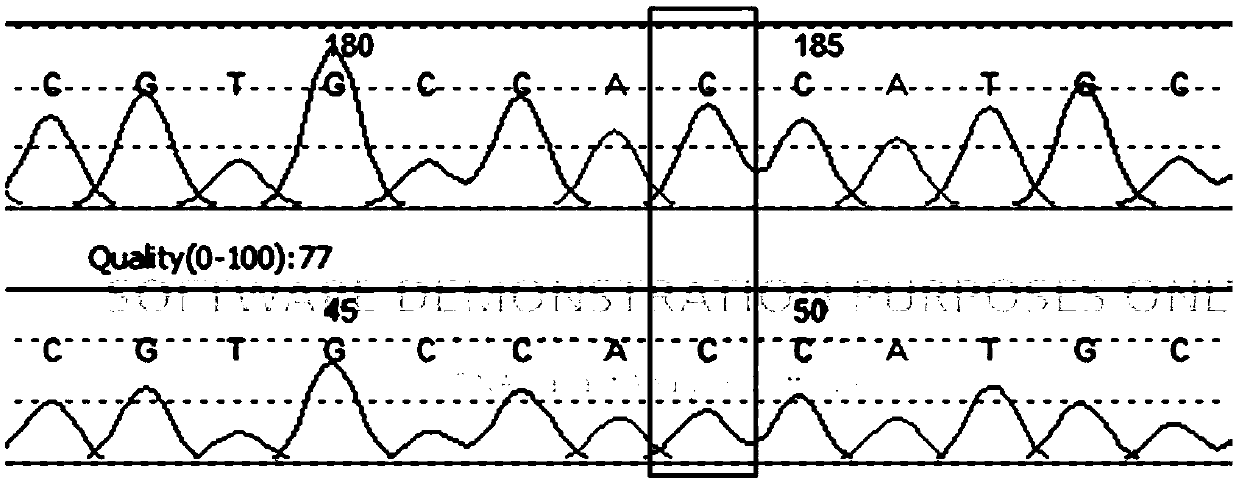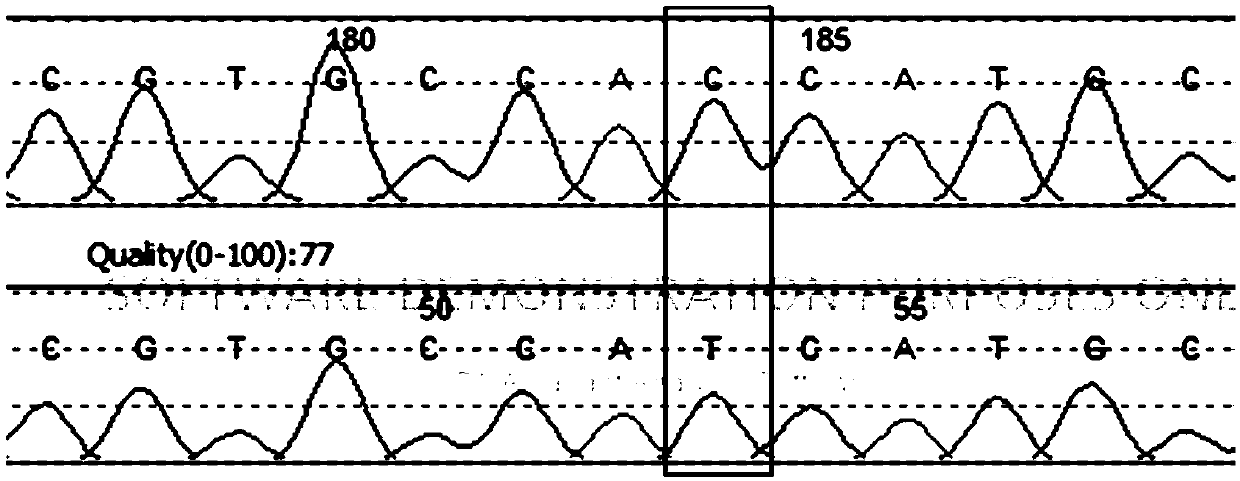Primer and method for detecting FGD1 gene mutation
A sequencing primer, FGD1-EXON-3-F technology, applied in the field of life sciences and biology, can solve problems such as interference signal transmission system, spatial structure change, etc., and achieve the effect of difficult detection, low cost and high cost
- Summary
- Abstract
- Description
- Claims
- Application Information
AI Technical Summary
Problems solved by technology
Method used
Image
Examples
Embodiment 1
[0030] The present invention will be further described below in conjunction with specific embodiments and accompanying drawings. It should be noted that the routine conditions and methods not described in the examples are generally used by experimenters in the field: for example, the fourth edition of the "Refined Molecular Biology Experiment Guide" edited by Osper and Kingston, Or follow the procedures and conditions recommended by the manufacturer.
[0031] A primer and method for detecting FGD1 659+27T>C and 482-113C>T site mutations. Increase primer, its base sequence is:
[0032] FGD1-EXON-3-F: TGTAAAACGACGGCCAGTGCCTCCTGAGTTCAAGCAAT
[0033] FGD1-EXON-3-R: AACAGCTATGACCATGTCTGAGGTGGGTGGTGGAC.
[0034] A kit for detecting FGD1 659+27T>C and 482-113C>T site mutations, comprising
[0035] (i) Blood DNA extraction reagents;
[0036] (ii) detection system PCR reaction solution;
[0037] (iii) Sequencing system reagents;
[0038] (iv) Positive control substance and negat...
Embodiment 2
[0043] The operation process of the blood genomic DNA extraction kit (Tiangen Biology):
[0044] (1) Genomic DNA extraction from blood
[0045] 1) Take 300 μl of blood and add 900 μl of erythrocyte lysate, mix by inversion, and let stand at room temperature for 5 minutes, during which time, invert and mix several times. Centrifuge at 12,000rpm for 1min, suck off the supernatant, leave the white blood cell pellet, add 200μl buffer GA, shake until thoroughly mixed.
[0046] 2) Add 20 μl proteinase K solution and mix well.
[0047] 3) Add 200 μl of buffer GB, mix thoroughly by inversion, place at 70°C for 10 minutes, the solution should become clear, and briefly centrifuge to remove water droplets on the inner wall of the tube cap.
[0048] 4) Add 200 μl of absolute ethanol, vortex and mix well for 15 seconds. At this time, flocculent precipitates may appear. Briefly centrifuge to remove water droplets on the inner wall of the tube cap.
[0049] 5) Add the solution and floccul...
Embodiment 3
[0080] Take 20 cases of clinical samples, extract genomes, prepare reagents and detect according to the methods described in Examples 1 and 2. Add 1 μL of the sample to the PCR reaction solution of the detection system, and make a positive, negative, and blank control at the same time. Electrophoresis results such as figure 1 As shown, it shows that the primers of the present invention can effectively amplify blood samples, and the band is single.
[0081] After sequencing, a total of 8 samples were found to have FGD1 659+27T>C and 482-113C>T mutations, which were samples 1, 2, 6, 10, 11, 12, 13, and 18, and the two mutations occurred simultaneously in the samples. And all were homozygous mutations. The sequencing results of sample 1 (positive sample) and sample 3 (negative sample) are as follows Figure 2-5 shown. figure 2 and image 3 Sequencing screenshots of FGD1 659+27T site-negative and positive samples. Figure 4 and Figure 5 Sequencing screenshots of FGD1 482-...
PUM
 Login to View More
Login to View More Abstract
Description
Claims
Application Information
 Login to View More
Login to View More - Generate Ideas
- Intellectual Property
- Life Sciences
- Materials
- Tech Scout
- Unparalleled Data Quality
- Higher Quality Content
- 60% Fewer Hallucinations
Browse by: Latest US Patents, China's latest patents, Technical Efficacy Thesaurus, Application Domain, Technology Topic, Popular Technical Reports.
© 2025 PatSnap. All rights reserved.Legal|Privacy policy|Modern Slavery Act Transparency Statement|Sitemap|About US| Contact US: help@patsnap.com



